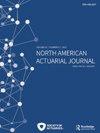Estimation, Comparison, and Projection of Multifactor Age–Cohort Affine Mortality Models
IF 1.6
Q3 BUSINESS, FINANCE
引用次数: 0
Abstract
Affine mortality models, developed in continuous time, are well suited to longevity risk applications including pricing and capital management. A major advantage of this mortality modeling approach is the availability of closed-form cohort survival curves, consistent with the assumed time dynamics of mortality rates. This article makes new contributions to the estimation of multifactor continuous-time affine models including the canonical Blackburn-Sherris, the arbitrage-free Nelson-Siegel (AFNS), and the Cox-Ingersoll-Ross (CIR) mortality models. We discuss and address numerical issues with model estimation. We apply the estimation methods to age–cohort mortality data from five different countries, providing insights into the dynamics of mortality rates and the fitting performance of the models. We show how the use of maximum likelihood with the univariate Kalman filter turns out to be faster and more robust compared to traditional estimation methods that heavily use large matrix multiplication and inversion. We present graphical and numerical goodness-of-fit results and assess model robustness. We project cohort survival curves and assess the out-of-sample performance of the models for the five countries. We confirm previous results by showing that, across these countries, although the CIR mortality model fits the historical mortality data well, particularly at older ages, the canonical and AFNS affine mortality models provide better out-of-sample performance. We also show how these affine mortality models are robust with respect to the set of age–cohort data used for parameter estimation. R code is provided.多因素年龄队列仿射死亡率模型的估计、比较和预测
在连续时间内开发的仿射死亡率模型非常适合长寿风险应用,包括定价和资本管理。这种死亡率建模方法的一个主要优点是可获得封闭形式的队列生存曲线,与假定的死亡率时间动态相一致。本文对典型的Blackburn-Sherris、无套利Nelson-Siegel (AFNS)和Cox-Ingersoll-Ross (CIR)死亡率模型等多因素连续时间仿射模型的估计作出了新的贡献。我们讨论和解决模型估计的数值问题。我们将估计方法应用于来自五个不同国家的年龄队列死亡率数据,提供了对死亡率动态和模型拟合性能的见解。我们展示了与大量使用大矩阵乘法和反演的传统估计方法相比,如何使用单变量卡尔曼滤波器的最大似然变得更快,更稳健。我们给出了图形和数值拟合优度结果,并评估了模型的稳健性。我们预测了这五个国家的队列生存曲线,并评估了模型的样本外性能。我们证实了之前的结果,表明在这些国家中,尽管CIR死亡率模型很好地符合历史死亡率数据,特别是在老年人中,规范和AFNS仿射死亡率模型提供了更好的样本外性能。我们还展示了这些仿射死亡率模型对于用于参数估计的年龄队列数据集的鲁棒性。提供R代码。
本文章由计算机程序翻译,如有差异,请以英文原文为准。
求助全文
约1分钟内获得全文
求助全文

 求助内容:
求助内容: 应助结果提醒方式:
应助结果提醒方式:


